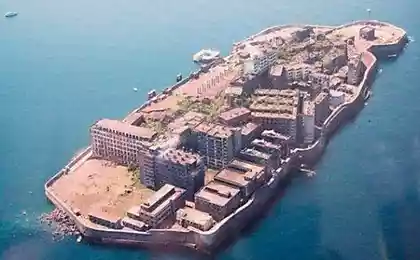1184
Deserted island ghost Hasim
For half a century Hasim was the most densely populated place on the planet. In an area of 3, 5 hectares lived here for more than five thousand people: the city and its dungeon, literally swarmed by people. April 20, 1974 the last local resident stepped onto the deck of the ship, care in Nagasaki, and now nearly 40 years dating back to the early XX century, high-rise buildings live only occasional seagull. The story will focus on the industrial history of this sad and miners ghost island, the island-battleship, the Japanese Hasim, mecca of all lovers of mankind abandoned cities.
Author darriuss

"The border island", exactly Hasim translated from Japanese, is located on the south of the country, in the East China Sea, 15 kilometers from the infamous Nagasaki. His second name, probably even more popular in Japan - Gunkandzima "battleship island".
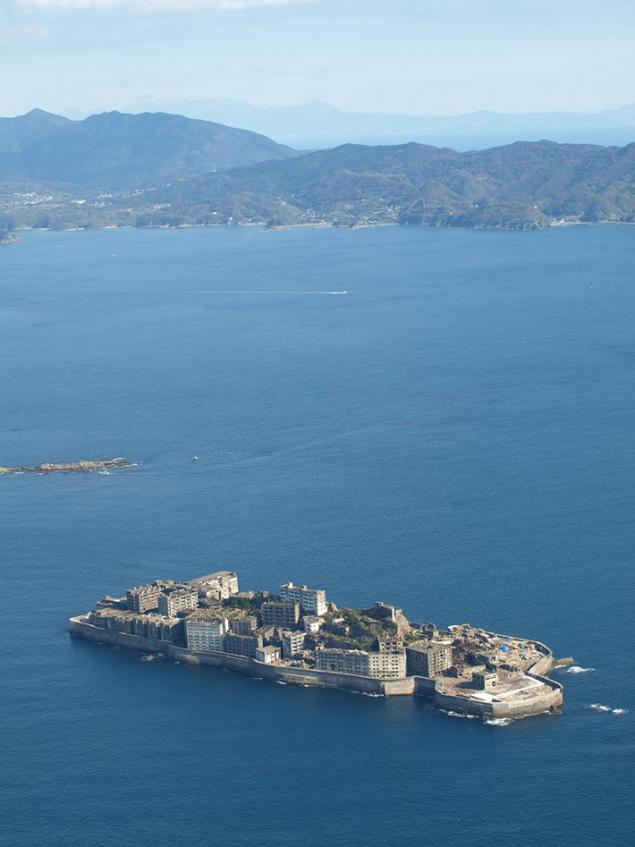
So he was called back in the 1920s. The journalists of the local newspaper noted that Hasim silhouette resembles a huge battleship Tosa, which was built at the time by Mitsubishi shipyard in Nagasaki. Battleship length of 234 meters was to be the flagship of the Imperial Navy of Japan, but became a victim of the "Treaty of five powers' agreement signed in 1922 in Washington, DC and is limited naval armaments. Nevertheless, "ship" nickname stuck firmly to Hasim, especially because eventually the island, in fact, repeated the fate of the battleship.

...

Hasim has not always looked so impressive. By the end of the XIX century it was one of a great many unsuitable for intelligent life forms rocky islets in the vicinity of Nagasaki, popular only among the local birds and occasionally frequented by fishermen

That changed in the 1880s. Japan experienced a strong industrialization, the most valuable resource in which became coal. The grand success of the neighboring island of Takashima mines has encouraged the development of alternative sources of raw materials, capable of thriving metallurgy Nagasaki.

In 1887, the first mine to Hasim founded Fukahori family clan, and in 1890 the island for 100,000 yen bought Mitsubishi, one of Japan's largest industrial conglomerates. At the end of the century photographs Hasim looks already inhabited, people began to actively develop its natural resources.
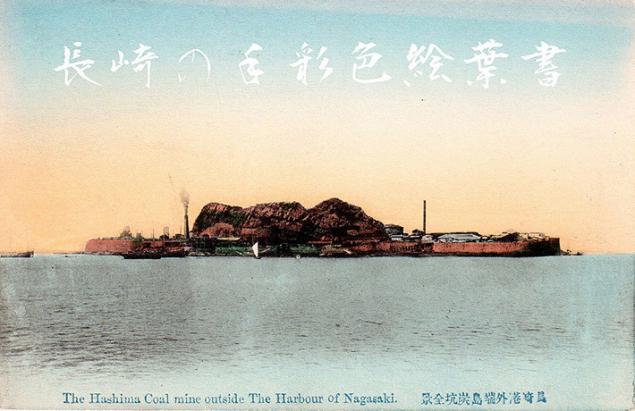
A coal country needed more and more. The growth was accompanied by a large industry and an increase in appetite, as it was customary to say before, the Japanese military aggression. Success in the Sino-Japanese (1894-95) and the Russian-Japanese (1904-05) war, only warmed up the economy of the empire. Concern Mitsubishi, have almost unlimited financial resources, developed the project of underwater coal mining on Hasim. In 1895 the company opened a new mine depth of 199 meters and another one - in 1898. Eventually, under the Hasim and the surrounding sea formed a labyrinth of underground and underwater excavation to a depth of 600 meters below sea level.
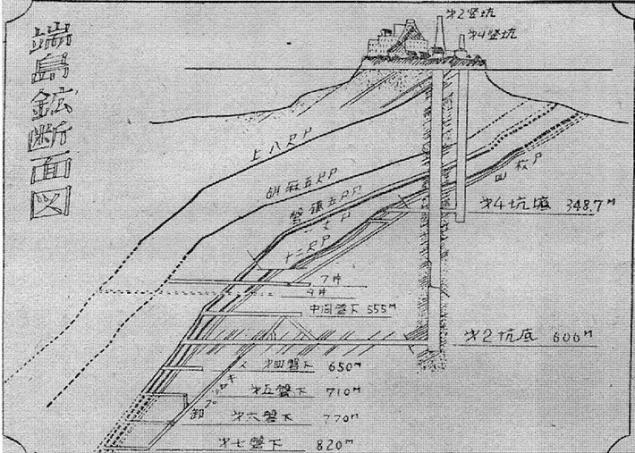
Waste rock extracted from the mines, Mitsubishi used to increase the island. The company's management has developed a plan to build an entire city for Hasim miners and support personnel. This was demanded by the growing scale of coal production and cost considerations, because in this case it was possible to give up the daily delivery of new shifts by sea from Nagasaki

Ultimately Hasim area, largely reclaimed from the Pacific Ocean, was 6, 3 hectares. From west to east the length of the island is 160 meters from north to south - 480 meters. In 1907, Mitsubishi has surrounded his property reinforced concrete walls that prevented the erosion of its territory and the sea are frequent typhoons.

In 1916, when Hasim was already producing 150,000 tons of coal per year, and its population is about 3,000, Mitsubishi beginning of large-scale construction here. For 58 years, the corporation has built here some 30 apartment houses, a hospital, schools, kindergartens, swimming pools, churches, cinemas and clubs for miners. Some shops on the island are 25 pieces. Its silhouette has finally begun to resemble a battleship Tosa, Hasim got his nickname.

The plan marked the main objects of the island, battleship, which will be mentioned later. 1 - Hospital 2 - the house №65, 3 - school, 4 - complex Nikkyu, 5 - "Glover House", 6 - a playground, a 7 - zone mines, 8 - cinema.
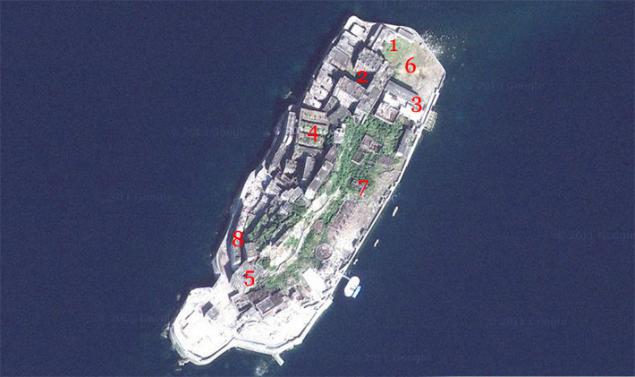
,,

The first major building became Hasim t. N. "Glover House" (pictured below under 1), named after the supposedly designed by the Scottish engineer Thomas Glover. The seven-story apartment building with a shop for the miners on the ground floor and a rooftop garden put into operation in 1916. It was Japan's first concrete building of this magnitude. Hasim basically became a testing ground for a new building material for the country, allows to erect buildings unprecedented scale.

...
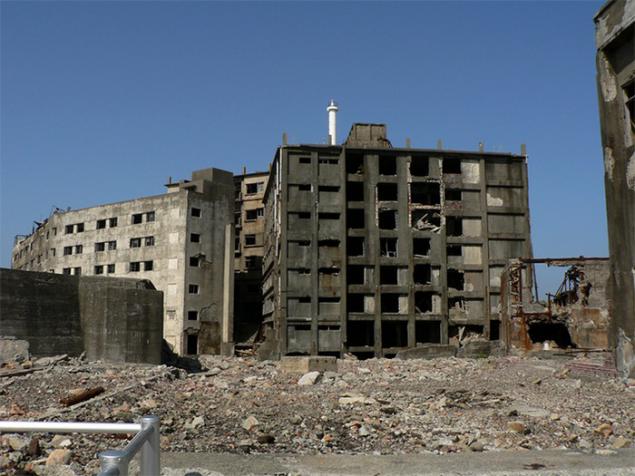
Square in plan building with a courtyard serves one purpose - to give shelter to the greatest number of workers. Standard apartment was more like a cell: a room of 10 square meters with a window and a small hallway. Kitchen, bathroom and toilet were shared on the floor. In fact, it was a hostel in its modern sense.

,,,
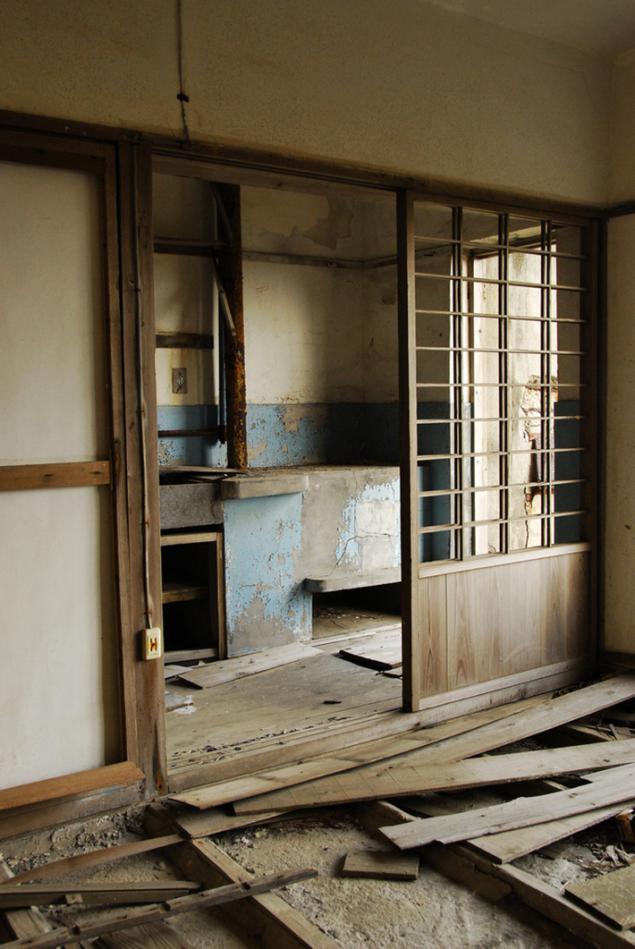
Two years later, in the central part of the island there was an even larger complex called Nikkyu. Nine-colossus in the form of the letter E totaled 241 as modest as its predecessor, the room.
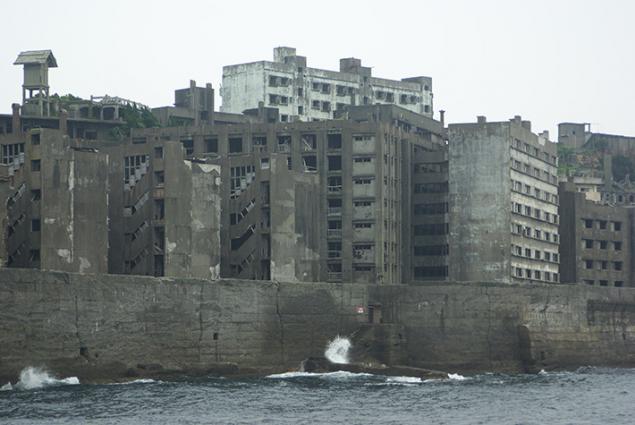
...
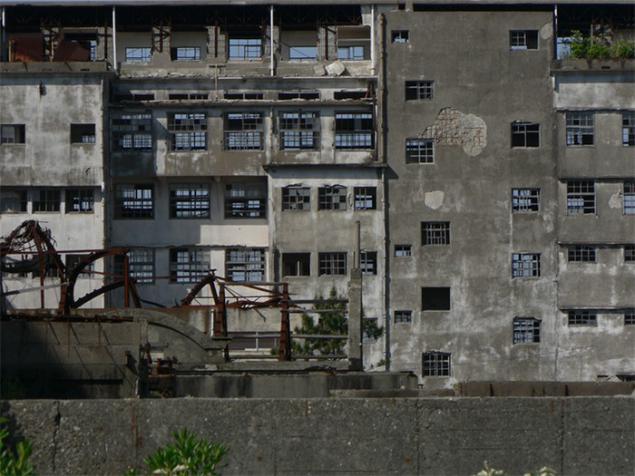
Any space in an extremely limited area tried to use efficiently. The extremely narrow courtyards between the buildings and the slope of the cliff were organized small public gardens for recreation of residents.

Construction of houses is continued even during the Second World War, when in other parts of the country it was frozen. Fuel is still needed belligerent empire. In 1941, at Hasim we set a record - produced 410,000 tons of coal and in 1944 Mitsubishi has been the construction of the largest residential complex here - t. N. "Building №65», 9-storey U-shaped building at 317 apartments, only house of its kind built in Japan in the first half of 1940.

...

...

Next to it is t. N. "Crossroads salty rain" - one of the few places on the island, which has not reached the waves of the East China Sea during the typhoon. Here, the population of a residential neighborhood could wait a bad weather before crossing the open winds and the sea space.

Nearby is another cult object Hasim - "Stairway to hell." Seemingly endless rise of local residents led to the temple Senpukuji. It is not clear that the inhabitants of the island seemed more hellish - the need to overcome the hundreds of steep steps or the subsequent descent into the narrow labyrinths of often had not seen sunlight.
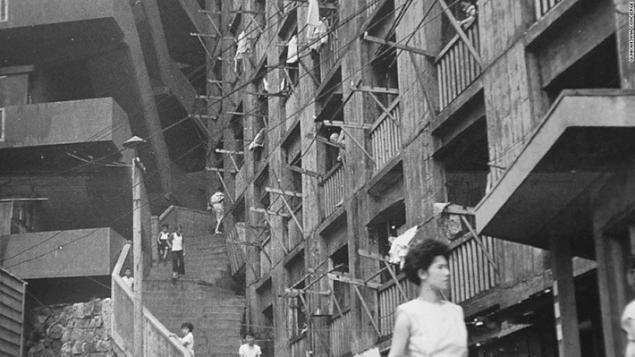
...

Hasim to the temple to be taken seriously - mining work and now, but in the first half of the XX century, in particular, remains extremely dangerous. During World War II many of the young miners islands were drafted into the army, Mitsubishi replaced them with guest workers from China and Korea. According to various estimates the victims of ruthless exploitation of the mines, and half-starved existence began in 1300 brought the captives here. Someone died in the mine, someone dying of starvation and disease, accidents happen even rushed to the walls of the island in a desperate, in most cases, a vain attempt to get to the "mainland." And of course, the number of dead at 87 years of Hasim mining here is not limited. On the island of conscience and Mitsubishi thousands of lives.

After the war, coal Hasim was still in demand. Japan's economy began a rapid recovery in the peaceful way. 1950 became the "golden decade" of the island: the company became the owner to do business much more civilized. In the mining town hospital was built, and in 1958 opened a huge 7-storey school, which became the last major building erected here.

...

From the first to the fourth floor of the complex occupied a primary school, located above the high school. At the top level there is a sports and assembly halls.

The peak population of Hasim reached in 1959. On six acres with a small island, of which only 60% were residential, lived 5259 people. The population density here was 1391 persons per hectare - in this sense, Hasim competitors were not. It was the most densely populated places on the planet - residential areas were literally packed with people.

Cars are, of course, it was not. As was said by locals from one end to the other it was possible to cross the island faster than a cigarette. Not even umbrellas were needed: an intricate maze of closed stairways, corridors and galleries united nearly all the buildings of residential areas, allowing, if necessary, in principle, do not go out into the open air.

...

...

The distribution of housing is reflected reigned strict social hierarchy. Single storey house, and on top of the rock, which was once the island began, he held managing mine Mitsubishi. Management, teachers and doctors lived in a relatively spacious one bedroom apartment with its own kitchen and bathroom in separate homes.

Miner's families also provided one-bedroom apartment of 20 square meters, but with kitchens, toilets and showers "on the floor." And unmarried miners, seasonal workers lived in the very first one-room apartment in the 10 "squares" built here in the early XX century.

Mitsubishi Hasim rules with an iron hand by setting here a kind of private-dictatorship. On the one hand, the corporation provided the miners secure jobs and pay, free housing, electricity and water. On the other - the inhabitants of the island forcibly brought to work on the content of public buildings in decent form cleaning of public spaces and territories.

The island community gave the "big land" because she needs coal, but, in turn, its existence is entirely dependent on the supply of food, clothing, and even plain water. Until 1960 there was not any more or less serious plant, but in 1963 the parent company has delivered to Kyushu ground, which allowed to break on roofs of buildings, and the few sites available free small squares, gardens and orchards. Residents were able to Hasim walk among the trees and to grow at least some minimum amount of vegetables.
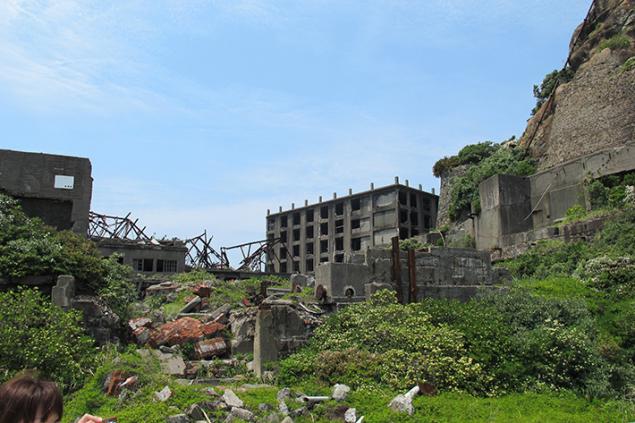
...

Future Hasim in the early 1960s still looked bright, but at the end of the decade with cheaper oil coal is becoming increasingly unprofitable. Mines were closed across the country and a small island in the East China Sea and in the end was the victim of a reorientation of the Japanese economy on the consumption of "black gold".

In January 1974 Mitsubishi announced the elimination of mines in Hasim in March closed 16 years ago, built a school and 20 April last resident left the island on his boat. Hasim has turned into a ghost.

For 87 years it has produced 16, 5 million tons of coal, but the last four decades, will leave the island, and built with such difficulty, with the slightest bit of land the building is slowly but irreversibly destroyed.

Abandoned people island-ship guarding the entrance to the bay of Nagasaki, serves as a monument to the history of Japanese society.

For a long time its visiting tourists and fans "zabroshki" was strictly forbidden - not actively degraded built in the first half of XX century buildings. However, since 2009, authorities again allowed to Hasim everyone by organizing a special walking route in a small but safe for the health of the island.
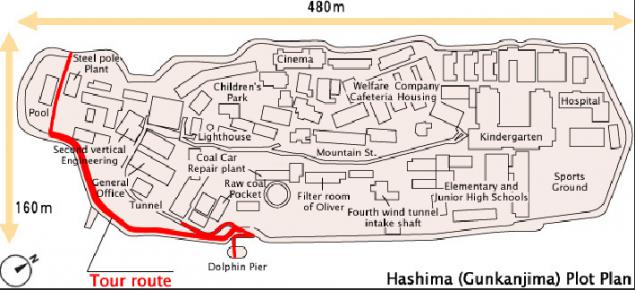
A new wave of interest raised Hasim latest epic series about the adventures of a British agent 007 James Bond. Lair of the main villain Raoul Silva in "Coordinates Skayfoll" (2012) was inspired by the obvious is the "island-battleship" in the East China Sea, though it was filmed in the halls of the British studio Pinewood.

,,
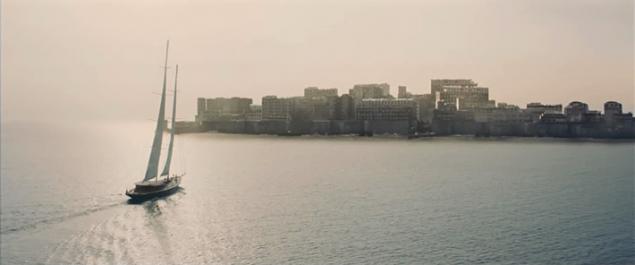
,,,

"The city is almost deserted for the night. He assured all that the leak at a chemical plant. "

...

...
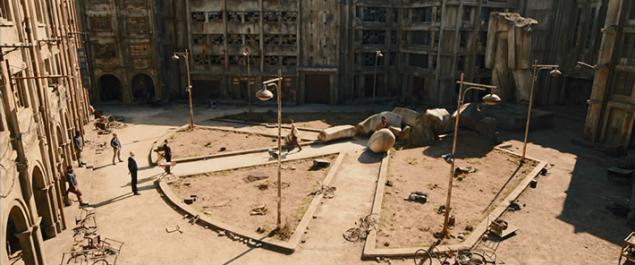
Enthusiasts offer to reconstruct the entire island, which is huge tourist potential, to organize a museum of industrial history in the open air, and even include Hasim as a UNESCO World Heritage Site.

However, as usual, everything comes down to finances, budget recovery after dozens of buildings, many of which are half-ruined, it is difficult to predict.

However, wander around the island ghost Now anyone can not go because of their own computer. In July 2013 shoot Hasim service Google Street View made it possible to see not only inaccessible to tourists are now neighborhoods of the island, but even go inside abandoned buildings, go to the apartment and see the miners thrown out everyday objects.

...

Hasim "Japanese Pripyat", but without the radiation, remains a harsh symbol of the birth of a great empire in the industry and at the same time demonstrates that nothing is forever, even under the rising sun.

...
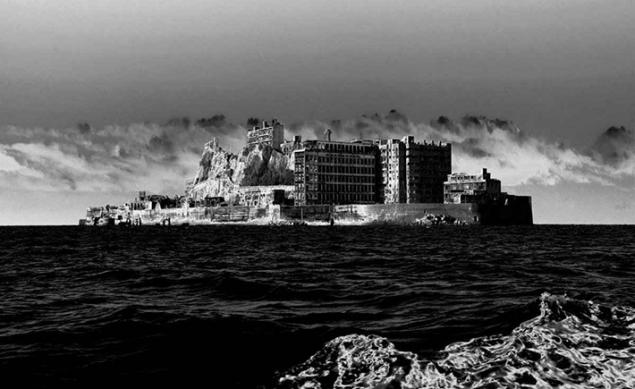
that's all,
thanks again for class darriuss text and tour

Source: http: //
Author darriuss

"The border island", exactly Hasim translated from Japanese, is located on the south of the country, in the East China Sea, 15 kilometers from the infamous Nagasaki. His second name, probably even more popular in Japan - Gunkandzima "battleship island".

So he was called back in the 1920s. The journalists of the local newspaper noted that Hasim silhouette resembles a huge battleship Tosa, which was built at the time by Mitsubishi shipyard in Nagasaki. Battleship length of 234 meters was to be the flagship of the Imperial Navy of Japan, but became a victim of the "Treaty of five powers' agreement signed in 1922 in Washington, DC and is limited naval armaments. Nevertheless, "ship" nickname stuck firmly to Hasim, especially because eventually the island, in fact, repeated the fate of the battleship.

...

Hasim has not always looked so impressive. By the end of the XIX century it was one of a great many unsuitable for intelligent life forms rocky islets in the vicinity of Nagasaki, popular only among the local birds and occasionally frequented by fishermen

That changed in the 1880s. Japan experienced a strong industrialization, the most valuable resource in which became coal. The grand success of the neighboring island of Takashima mines has encouraged the development of alternative sources of raw materials, capable of thriving metallurgy Nagasaki.

In 1887, the first mine to Hasim founded Fukahori family clan, and in 1890 the island for 100,000 yen bought Mitsubishi, one of Japan's largest industrial conglomerates. At the end of the century photographs Hasim looks already inhabited, people began to actively develop its natural resources.

A coal country needed more and more. The growth was accompanied by a large industry and an increase in appetite, as it was customary to say before, the Japanese military aggression. Success in the Sino-Japanese (1894-95) and the Russian-Japanese (1904-05) war, only warmed up the economy of the empire. Concern Mitsubishi, have almost unlimited financial resources, developed the project of underwater coal mining on Hasim. In 1895 the company opened a new mine depth of 199 meters and another one - in 1898. Eventually, under the Hasim and the surrounding sea formed a labyrinth of underground and underwater excavation to a depth of 600 meters below sea level.

Waste rock extracted from the mines, Mitsubishi used to increase the island. The company's management has developed a plan to build an entire city for Hasim miners and support personnel. This was demanded by the growing scale of coal production and cost considerations, because in this case it was possible to give up the daily delivery of new shifts by sea from Nagasaki

Ultimately Hasim area, largely reclaimed from the Pacific Ocean, was 6, 3 hectares. From west to east the length of the island is 160 meters from north to south - 480 meters. In 1907, Mitsubishi has surrounded his property reinforced concrete walls that prevented the erosion of its territory and the sea are frequent typhoons.

In 1916, when Hasim was already producing 150,000 tons of coal per year, and its population is about 3,000, Mitsubishi beginning of large-scale construction here. For 58 years, the corporation has built here some 30 apartment houses, a hospital, schools, kindergartens, swimming pools, churches, cinemas and clubs for miners. Some shops on the island are 25 pieces. Its silhouette has finally begun to resemble a battleship Tosa, Hasim got his nickname.

The plan marked the main objects of the island, battleship, which will be mentioned later. 1 - Hospital 2 - the house №65, 3 - school, 4 - complex Nikkyu, 5 - "Glover House", 6 - a playground, a 7 - zone mines, 8 - cinema.

,,

The first major building became Hasim t. N. "Glover House" (pictured below under 1), named after the supposedly designed by the Scottish engineer Thomas Glover. The seven-story apartment building with a shop for the miners on the ground floor and a rooftop garden put into operation in 1916. It was Japan's first concrete building of this magnitude. Hasim basically became a testing ground for a new building material for the country, allows to erect buildings unprecedented scale.

...

Square in plan building with a courtyard serves one purpose - to give shelter to the greatest number of workers. Standard apartment was more like a cell: a room of 10 square meters with a window and a small hallway. Kitchen, bathroom and toilet were shared on the floor. In fact, it was a hostel in its modern sense.

,,,

Two years later, in the central part of the island there was an even larger complex called Nikkyu. Nine-colossus in the form of the letter E totaled 241 as modest as its predecessor, the room.

...

Any space in an extremely limited area tried to use efficiently. The extremely narrow courtyards between the buildings and the slope of the cliff were organized small public gardens for recreation of residents.

Construction of houses is continued even during the Second World War, when in other parts of the country it was frozen. Fuel is still needed belligerent empire. In 1941, at Hasim we set a record - produced 410,000 tons of coal and in 1944 Mitsubishi has been the construction of the largest residential complex here - t. N. "Building №65», 9-storey U-shaped building at 317 apartments, only house of its kind built in Japan in the first half of 1940.

...

...

Next to it is t. N. "Crossroads salty rain" - one of the few places on the island, which has not reached the waves of the East China Sea during the typhoon. Here, the population of a residential neighborhood could wait a bad weather before crossing the open winds and the sea space.

Nearby is another cult object Hasim - "Stairway to hell." Seemingly endless rise of local residents led to the temple Senpukuji. It is not clear that the inhabitants of the island seemed more hellish - the need to overcome the hundreds of steep steps or the subsequent descent into the narrow labyrinths of often had not seen sunlight.

...

Hasim to the temple to be taken seriously - mining work and now, but in the first half of the XX century, in particular, remains extremely dangerous. During World War II many of the young miners islands were drafted into the army, Mitsubishi replaced them with guest workers from China and Korea. According to various estimates the victims of ruthless exploitation of the mines, and half-starved existence began in 1300 brought the captives here. Someone died in the mine, someone dying of starvation and disease, accidents happen even rushed to the walls of the island in a desperate, in most cases, a vain attempt to get to the "mainland." And of course, the number of dead at 87 years of Hasim mining here is not limited. On the island of conscience and Mitsubishi thousands of lives.

After the war, coal Hasim was still in demand. Japan's economy began a rapid recovery in the peaceful way. 1950 became the "golden decade" of the island: the company became the owner to do business much more civilized. In the mining town hospital was built, and in 1958 opened a huge 7-storey school, which became the last major building erected here.

...

From the first to the fourth floor of the complex occupied a primary school, located above the high school. At the top level there is a sports and assembly halls.

The peak population of Hasim reached in 1959. On six acres with a small island, of which only 60% were residential, lived 5259 people. The population density here was 1391 persons per hectare - in this sense, Hasim competitors were not. It was the most densely populated places on the planet - residential areas were literally packed with people.

Cars are, of course, it was not. As was said by locals from one end to the other it was possible to cross the island faster than a cigarette. Not even umbrellas were needed: an intricate maze of closed stairways, corridors and galleries united nearly all the buildings of residential areas, allowing, if necessary, in principle, do not go out into the open air.

...

...

The distribution of housing is reflected reigned strict social hierarchy. Single storey house, and on top of the rock, which was once the island began, he held managing mine Mitsubishi. Management, teachers and doctors lived in a relatively spacious one bedroom apartment with its own kitchen and bathroom in separate homes.

Miner's families also provided one-bedroom apartment of 20 square meters, but with kitchens, toilets and showers "on the floor." And unmarried miners, seasonal workers lived in the very first one-room apartment in the 10 "squares" built here in the early XX century.

Mitsubishi Hasim rules with an iron hand by setting here a kind of private-dictatorship. On the one hand, the corporation provided the miners secure jobs and pay, free housing, electricity and water. On the other - the inhabitants of the island forcibly brought to work on the content of public buildings in decent form cleaning of public spaces and territories.

The island community gave the "big land" because she needs coal, but, in turn, its existence is entirely dependent on the supply of food, clothing, and even plain water. Until 1960 there was not any more or less serious plant, but in 1963 the parent company has delivered to Kyushu ground, which allowed to break on roofs of buildings, and the few sites available free small squares, gardens and orchards. Residents were able to Hasim walk among the trees and to grow at least some minimum amount of vegetables.

...

Future Hasim in the early 1960s still looked bright, but at the end of the decade with cheaper oil coal is becoming increasingly unprofitable. Mines were closed across the country and a small island in the East China Sea and in the end was the victim of a reorientation of the Japanese economy on the consumption of "black gold".

In January 1974 Mitsubishi announced the elimination of mines in Hasim in March closed 16 years ago, built a school and 20 April last resident left the island on his boat. Hasim has turned into a ghost.

For 87 years it has produced 16, 5 million tons of coal, but the last four decades, will leave the island, and built with such difficulty, with the slightest bit of land the building is slowly but irreversibly destroyed.

Abandoned people island-ship guarding the entrance to the bay of Nagasaki, serves as a monument to the history of Japanese society.

For a long time its visiting tourists and fans "zabroshki" was strictly forbidden - not actively degraded built in the first half of XX century buildings. However, since 2009, authorities again allowed to Hasim everyone by organizing a special walking route in a small but safe for the health of the island.

A new wave of interest raised Hasim latest epic series about the adventures of a British agent 007 James Bond. Lair of the main villain Raoul Silva in "Coordinates Skayfoll" (2012) was inspired by the obvious is the "island-battleship" in the East China Sea, though it was filmed in the halls of the British studio Pinewood.

,,

,,,

"The city is almost deserted for the night. He assured all that the leak at a chemical plant. "

...

...

Enthusiasts offer to reconstruct the entire island, which is huge tourist potential, to organize a museum of industrial history in the open air, and even include Hasim as a UNESCO World Heritage Site.

However, as usual, everything comes down to finances, budget recovery after dozens of buildings, many of which are half-ruined, it is difficult to predict.

However, wander around the island ghost Now anyone can not go because of their own computer. In July 2013 shoot Hasim service Google Street View made it possible to see not only inaccessible to tourists are now neighborhoods of the island, but even go inside abandoned buildings, go to the apartment and see the miners thrown out everyday objects.

...

Hasim "Japanese Pripyat", but without the radiation, remains a harsh symbol of the birth of a great empire in the industry and at the same time demonstrates that nothing is forever, even under the rising sun.

...

that's all,
thanks again for class darriuss text and tour

Source: http: //















